전시
-
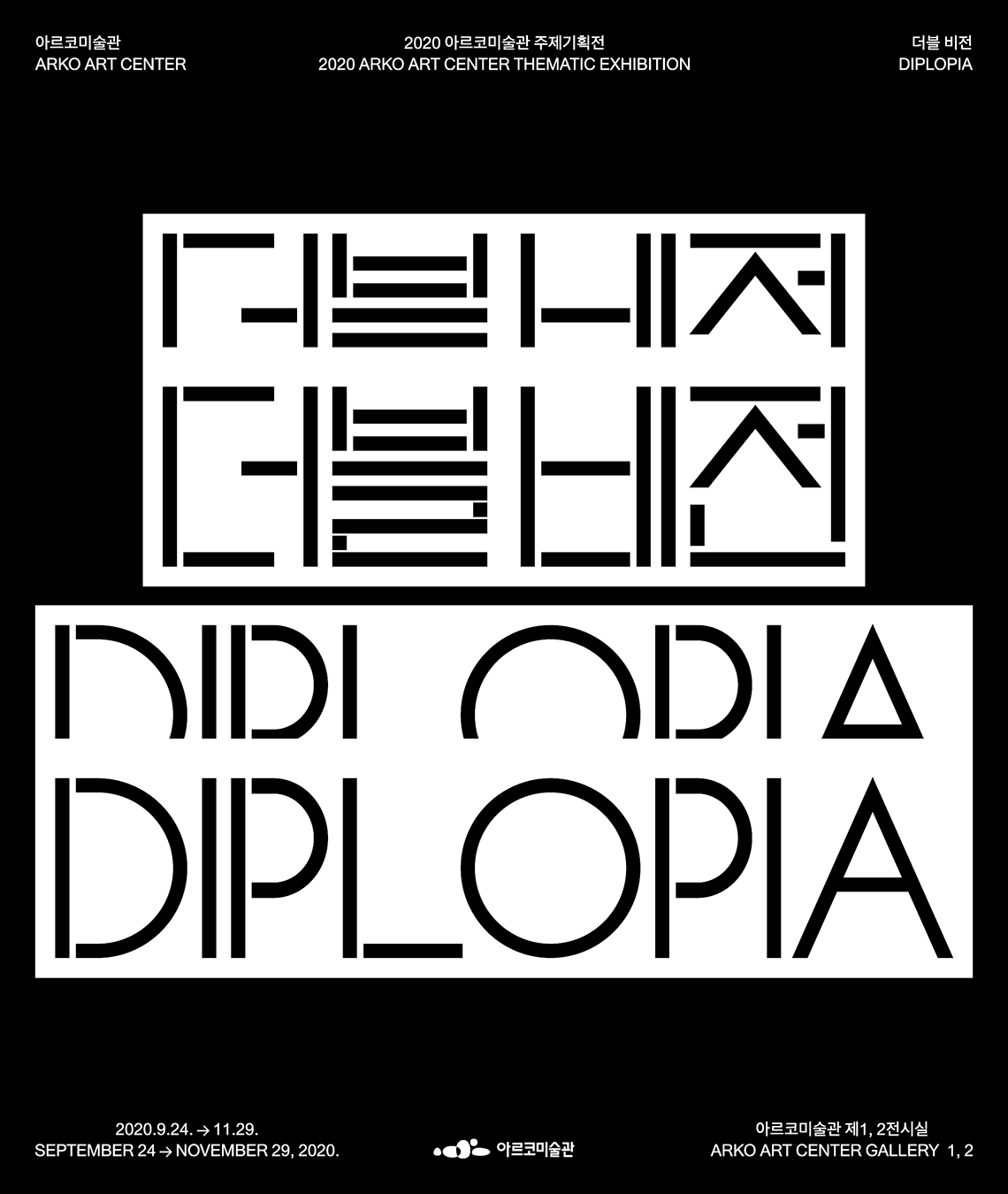 2020년 아르코미술관 주제기획전 《더블 비전 Diplopia》
2020년 아르코미술관 주제기획전 《더블 비전 Diplopia》- 전시기간
- 2020.09.24~2020.11.29
- 관람료
- 무료
- 오프닝
- 온라인 오프닝 : 2020년 9월 24일, 오후 6시
- 장소
- 아르코미술관 제1,2전시실
- 작가
- 김실비, 양아치, 오민수, 이은희, 임영주
- 부대행사
- 강연, 토크 프로그램, 리딩클럽 (자세한 사항은 아래 참고)
- 주관
- 아르코미술관
- 주최
- 한국문화예술위원회
- 문의
2020 아르코미술관 주제기획전 《더블 비전 Diplopia》
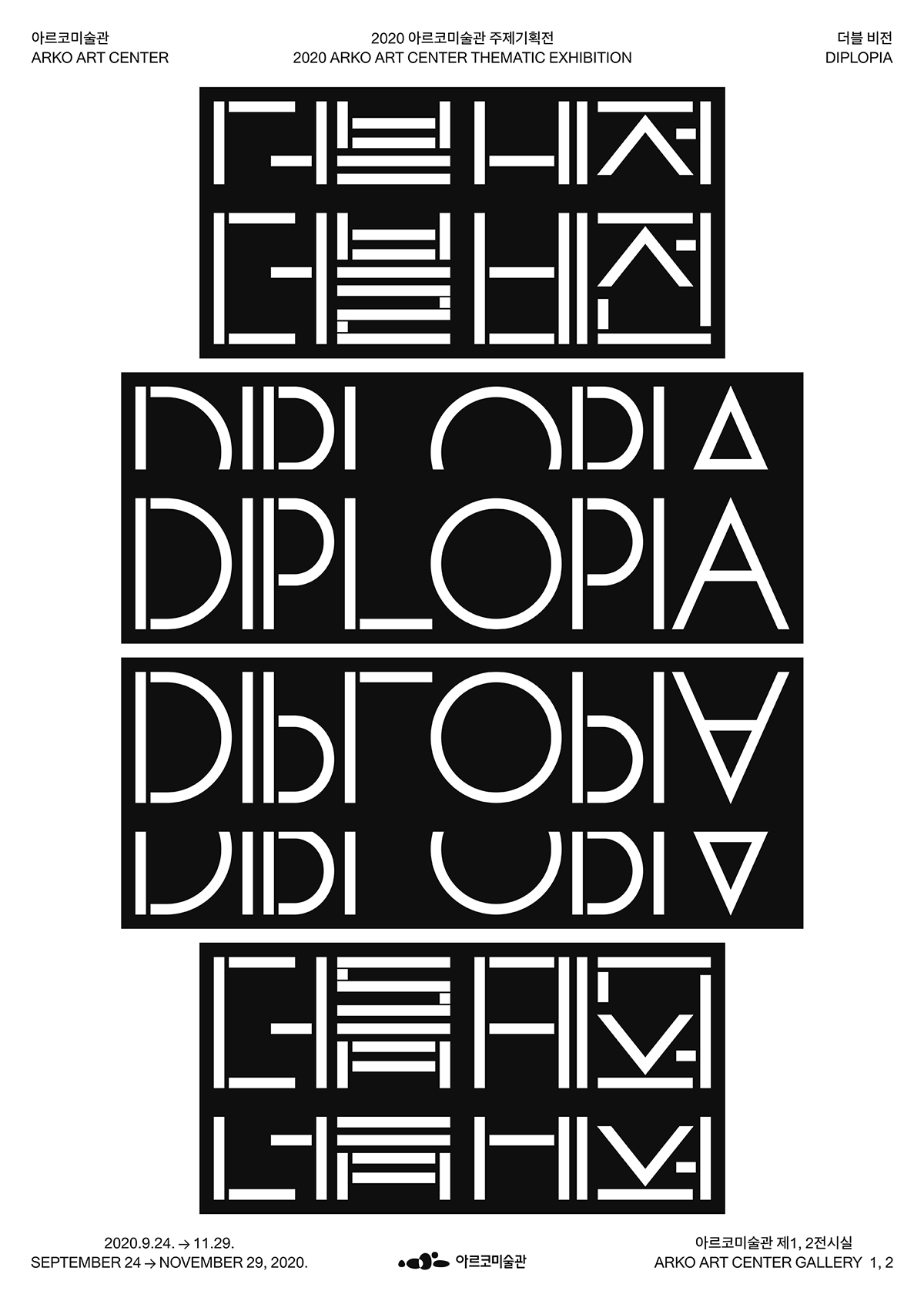
▣ 전시개요
- 전시일시 : 2020년 9월 24일(목) - 11월 29일(일)
- 전시관람 온라인 사전예약 링크 : https://booking.naver.com/booking/12/bizes/410759
※사전신청은 선착순 예약제로 운영되며, 사전신청 가능인원은 1명당 2명까지 신청가능합니다.
※사전신청 후 방문이 어려울시 방문일 하루 전까지 사전취소 부탁드립니다.
※온라인 사전예약 접수를 우선으로 하며, 온라인 사전예약 미달 및 취소 시 해당 인원수에 한정하여 현장 접수가 가능합니다.
- 온라인 오프닝 : 2020년 9월 24일, 오후 6시
*별도의 초대일시가 없으며, 온라인 오프닝이 인스타그램과 유튜브 라이브로 중계됩니다.
- 전시장소 : 아르코미술관 제1,2전시실
- 관람료 : 무료
- 부대행사 : 강연, 토크 프로그램, 리딩클럽 (자세한 사항은 아래 참고)
- 참여작가: 김실비, 양아치, 오민수, 이은희, 임영주
- 텍스트 참여 : 아그라파 소사이어티
- 주최 : 한국문화예술위원회
- 운영시간: 화-일요일, 오전 11시-오후 7시
*오후 6시 30분까지 입장가능
*매월 마지막 주 수요일은 21:00까지 운영
*단체 관람 및 전시 해설 서비스는 진행하지 않으며, 아르코미술관 온라인 전시 영상으로 이를 대체합니다.
▣ 전시소개
우리의 세기는 과학기술의 한 챕터 속에 살고 있다. 4차 산업혁명의 AI, 로봇공학, 생명공학은 우리의 삶을 편리하고 더 낫게 만든다는 전망을 설득력 있게 보여주고 있다. 인류세 시기의 환경위기의 대안, 그리고 비대면의 새로운 기준을 만드는 개척자이자 구원자로 4차 산업혁명이 등장한다. 과학기술 분야에 대한 기업과 경제의 쏠림현상, 유한한 생명의 영생을 약속하고 신체를 증강하기 위한 생명공학 기술은 얼마나 기술물신주의에 도취되어 있는지를 쉽게 알 수 있는 장면들이다. 일례로, 자율주행 자동차의 창업자 일론 머스크(Elon Musk)는 인간 뇌와 컴퓨터를 결합하는 뇌연구 스타트업 ‘뉴럴링크(Neuralink)’를 제시하기에 이른다. 이는 미래의 기술이 인공지능과 우리의 신체가 서로 반응하고 연쇄하는 트랜스 휴먼의 세계로 이끌 것을 예고하고, 우리는 이에 열광한다. 이처럼 기술이 그리는 매혹적인 미래의 환상은 끊임없이 재생된다. 치솟는 IT, 바이오 주식시장에 들끓는 정념들이 가득하다.
과학기술은 그 자체보다 자본주의 생산관계에 예속되어 있다는 것이 문제적이다. 이익과 목적을 위해 동원된 과학기술은 구체적인 삶과 인간의 몸을 소외시키고, 기술 시스템에서 데이터화, 자동화, 금융화한다. 말하자면 최첨단의 과학기술은 자본주의 사회에서 네트워크의 세계를 보다 긴밀하게 연결하며, 물질적인 것 그리고 신체를 코드, 데이터와 같은 비물질의 흐름으로 만든다. 숙박공유, 차량공유, 배달서비스와 같은 라이프 스타일과 관련된 공유플랫폼에서의 활동과 궤적은 신체를 삭제하고 망(net) 속의 정보 값으로 환원한다. 플랫폼 내 데이터의 생산과 소비가 비물질 노동으로 이어지는 인지자본주의에서는 사이버네틱스의 망의 세계에 예속된 것이 리얼리티가 되었다는 사실을 그리 놀랍지 않게 목격할 수 있다.
2020년 아르코미술관 주제기획전 더블 비전(Diplopia)은 4차 산업혁명과 과학기술의 비전을
향한 비대한 열망에 맞서 자본주의 사회에서 과학기술이 얽혀 나타나는 현상, 그리고 삶의 패턴과 신체 감각, 나아가 우리의 인식체계에 깊이 관여하는 생명정치 상황 이면의 세계를 보고자 한다. 이번 전시는 과학기술과 시장경제의 시스템이 인간의 활동을 예속하는 현상에서 탈주할 수 있는지 질문한다. 그것이 만약 불가능하다면 기계-시스템과 같은 비인간의 상호관계 속에서 변형되는 인간주체성의 인식과 감각, 도래할 미래의 모습을 살펴본다.
전시는 과학기술 낙관론이 향했던 인간중심주의와 기술물신주의에 대한 전환을 시도하며, 다시 묻는다. 과학기술이 만드는 지금의 형국과 장면, 이미지를 통과하며 과학기술과 관계 맺은 사건과 현상들이 인간의 활동과 존재, 개념에 균열을 내고, 어떠한 방식의 변형을 가하고 있는가. 그리고 인간이 기계 시스템과의 대척점에서 소외되는 것이 아니라 다시 관계 맺을 수 있도록 역전할 수 있는가.
다양한 형태로 펼쳐진 과학기술의 형태, 기계 시스템을 경험하며 접속하는 인간은 이제 자신이 가진 신체와 인지 조건을 달리할 수밖에 없다. 이는 한편으로 인간이 정동과 관계맺음에 영향 받고 불완전한 존재일 수밖에 없다는 것을 역설하는 것이기도 하다. 기계적인 것의 예속 앞에서 인간은 소외되지만 기계라는 비인간과 인터렉션하는 과정은 인간중심주의적으로 과학기술을 소유하는 것에 균열을 가져온다. 이러한 과정에서 인간은 기계시스템이라는 비인간과 —이질적이든 융합이든— 교섭할 틈을 열 수 있는 것은 아닐까.
전시의 제목인 ‘더블 비전’은 시각의 병리적 증상인 ‘복시(Double Vision)’, 즉 겹보임을 의미하는 의학용어 ‘디플로피아(Diplopia)’를 통해 현상을 징후적으로 보면서, 내재된 이중적인 비전을 보여주고자 한다. 더블 비전은 그간의 기술물신주의의 이면의 인간소외라는 부정성의 리얼리티를 만나게 하며, 이를 바탕으로 인간과 비인간의 조응하는 관계를 함께 꿈꿔본다. 우리의 세기가 열망하는 과학기술을 향한 과열된 신념, 판타지를 만들어내는 장면들, 그리고 과학기술이 자본의 생산체계와 얽힘 속에서 기계-시스템이 인간을 예속하는 상태, 이러한 예속상태에서 기계와 인간이 대치되는 것이 아닌 상호교차하는 관계 맺기 안에서 인간 너머의 장면을 겹쳐서 보기를 시도한다. 참여 작가들은 과학기술과 자본주의가 얽힌 체계에서 가려진 노동과 신체, 기계가 포착한 인류의 모습을 다루고, 이 안에서 불안의 정동, 다가올 근미래의 비전을 영상이미지와 사운드로 제시한다. 1, 2층 전시장의 겹쳐진 이중(Doubling) 구조 속 작품을 유기적으로 연결하고 해석하는 가운데, 오롯이 개인에게 남겨진 장면들은 이후의 챕터를 상상하기 위한 잠재적인 것으로 남을 것이라 기대한다.
작품설명
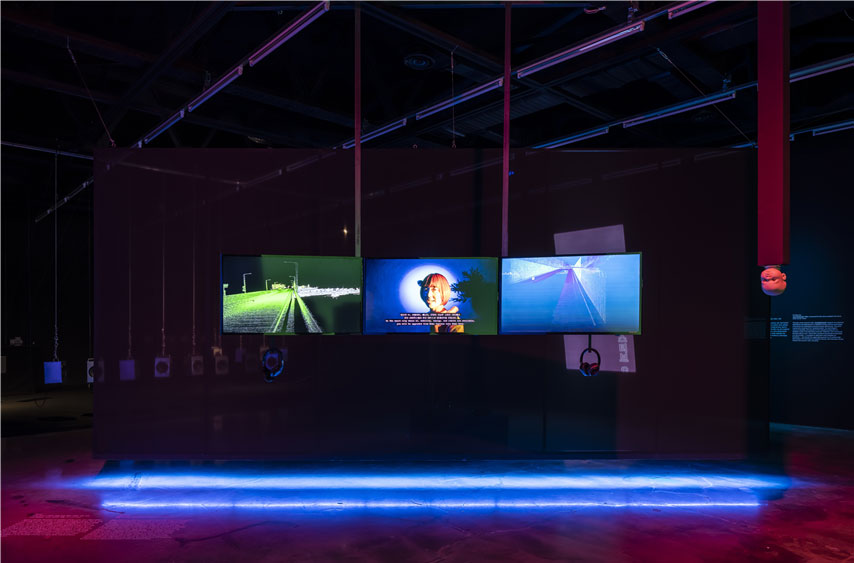
양아치
Sally, 2019 현재, 3채널 영상, 컬러, 사운드, 9분 19초
Sally, 2019 현재, 1채널 영상, 컬러, 사운드, 6분 40초
Sally Smiles, 2020, 실리콘, 광물, 17×13×14cm
이 영상은 인공지능 샐리(Sally)가 안내하는 근미래 스마트 시티 서울의 데이터 스케이프를 보여준다. 작가는 이 작업에서 곧 상용화될 인공지능, 에너지, 로봇, 스마트 시티에 대한 기술의 지식을 바탕으로 인류의 생활 패턴과 환경의 변화를 예견한다. 데이터의 생산과 소비, 이를 토대로 한 플랫폼 자본주의는 기본소득을 창출할 수 있는 모델로 전환될 수 있는가, 한 기업의 자율주행 자동차와 그에 따르는 기술력은 다양한 시간대와 스케일, 공간으로 우리를 연결할 수 있는가, 네트워크를 감각하고 접속할 수 있는 새로운 신체의 등장, 그리고 그 신체의 감각과 인식의 전환은 가능한가. “잠시 후 모든 것이 연결될 것”이라는 근미래로부터 온 인공지능의 예언은 모든 것이 연결 가능한 망(net)의 세계에서 물리적인 존재와 신체가 과연 접속할 수 있는가를 질문하게 한다. 영상은 도래할 기술의 미래에 대한 상상적 이미지이자 미래를 위한 광고처럼 비춰진다. 스크린에서 미래로부터 온 인공지능 샐리의 존재가 말을 걸어왔다면, 전시장에 놓인 오브제 Sally Smiles는 또 다른 미디어의 빛을 담는다. 오브제에 부착된 광물인 방해석은 고대에 바이킹족이 바다를 항해할 때 태양의 방향을 가늠하던 신화적 광물이자 자연으로부터 온 미디어다. 고대 또한 상상으로 접속 가능하다는 점에서 미래와 유사하며, 이 작업은 과거와 미래의 미디어를 연결하고, 또 두 전시장을 이어주는 시그널로 현재 시점에 존재하는 관객을 맞이한다.
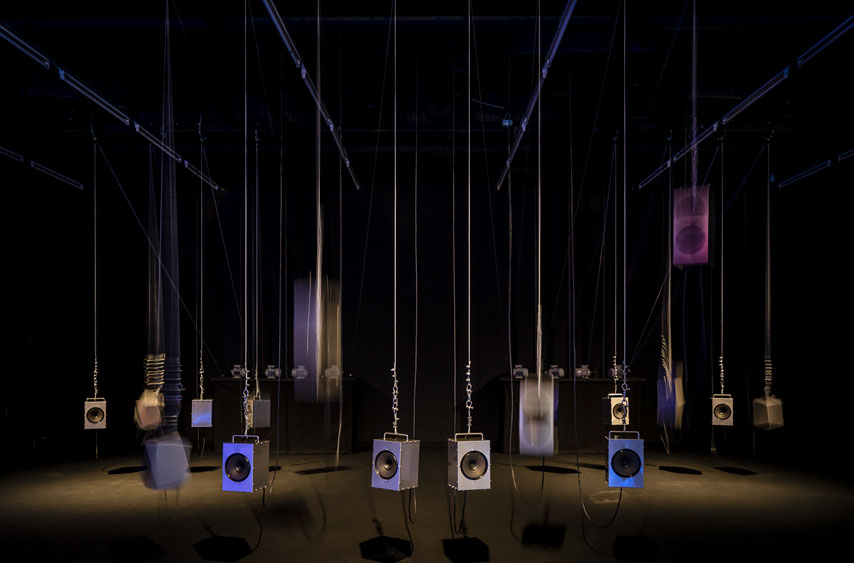
오민수
아웃소싱 미라클, 2020, 스피커, 모터 등 혼합매체, 가변설치
아웃소싱 미라클은 자본주의 시스템 뒤에 사라져간 노동자의 죽음을 기계의 증폭된 사운드와 키네틱 설치를 통해 보여준다. ‘아웃소싱’이라는 기업의 경제구조 시스템은 생산의 속도를 높이기 위한 것으로 이 구조에서 노동하는 인간은 한없이 취약함에 노출될 수밖에 없다. 작가는 이천 물류창고 화재 현장 그 이후, 폐허가 된 공간에서 녹음을 하고 그 소리를 통해 거대기업 구조의 노동현실을 드러내고자 한다. 사건의 현장에서 녹음된 화이트노이즈는 전시장에서 위아래로 움직이는 스피커를 거쳐 흘러나오는데, 이는 스피커의 물리적인 움직임으로 인해 소리가 증폭되고 감소되는 소리의 왜곡, 즉 도플러효과(Doppler Effect)로 나타난다. 이 작업은 시장경제의 경영구조와 기업의 생산 논리에 의한 희생과 재난의 재현 불가능성을 사운드 설치를 통해 이야기한다. 소리의 왜곡은 재현 불가능한 시간을 뭉개며, 우리가 경험하지 못한 시간과 소리의 층위로 안내한다. 화재 현장의 타오르는 불길, 돌이킬 수 없는 사태는 화이트노이즈 음의 1초로 살아나며, 뭉개진 시간의 소리 앞에서 우리는 죽음의 1초를 감지할 수 있을 것이다.
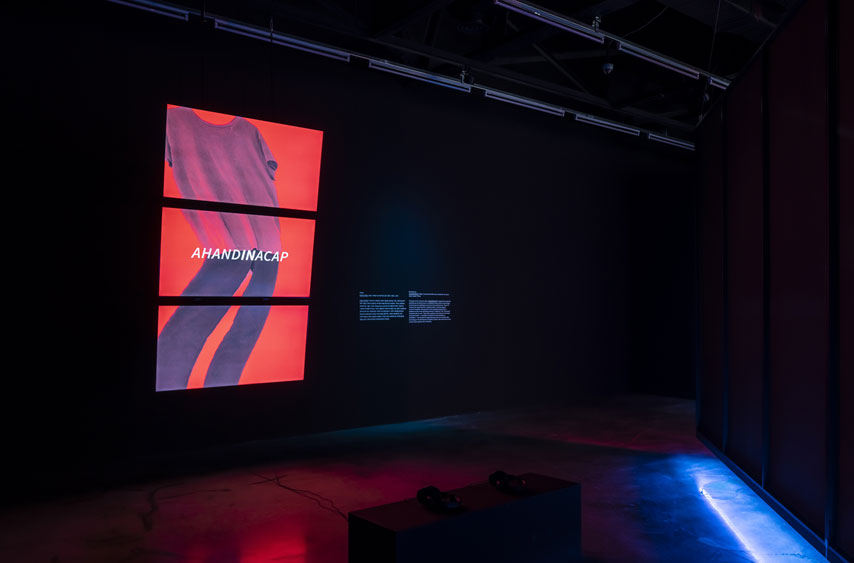
이은희
어핸드인어캡, 2020, 3채널 Full HD 영상 설치, 컬러, 사운드, 13분
어핸드인어캡은 자본주의 사회에서 신체의 결함을 판단하는 기준, 이를 개선하기 위해 기술과 과학이 동원되는 방식을 3채널 영상으로 보여준다. 한 영화의 푸티지로 시작하는 이 영상은 불의의 사고로 얻게 된 장애라는 결함을 극복하기 위해 포스트 휴먼으로 거듭나는 서사, 보험에서 장애를 판단하는 기준, 퍼포머의 움직임, 그리고 재활치료를 위해 동원되는 로봇치료의 장면으로 구성된다. 과학기술산업에서는 장애를 극복하기 위해 사이보그처럼 신체를 보철하는 신기술 개발을 강조하고 있다. 작가는 장애라는 어원에 담긴 ‘일할 수 없는 몸(disable-bodied)’의 의미를 탐구하며, 자본주의 사회에서 장애를 바라보는 시각은 결함에서 회복하여 일할 수 있는 몸과 구성원으로 돌아오도록 하는 이분법적인 구분이 아닌지를 묻는다. 나아가 장애를 판단하는 정상성과 비정상성의 기준은 무엇인가를 질문하며, 이러한 이분법적인 기준 안에 존재하는 장애 산업에서 최첨단의 기술이 점차 비대해져 갈 수밖에 없음을 돌봄노동자, 장애 당사자의 인터뷰를 통해 드러낸다.
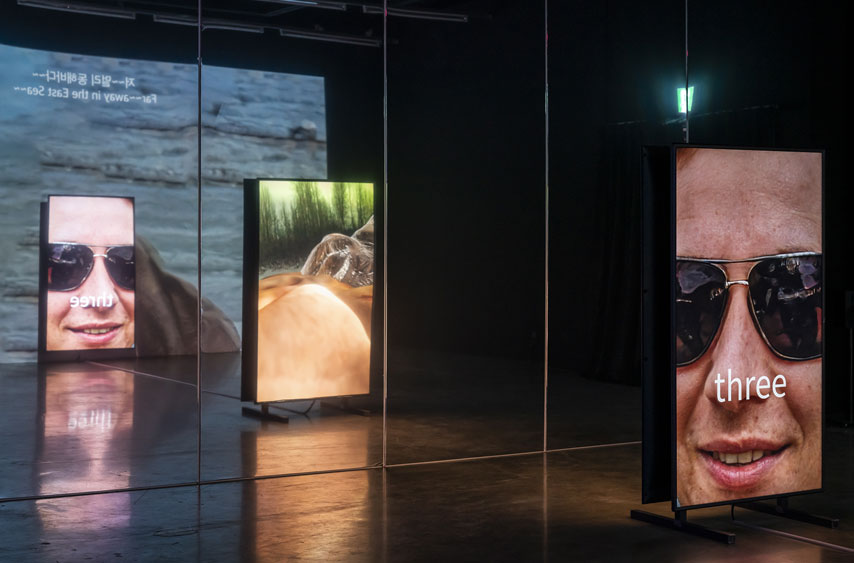
임영주
세타, 2020, 4채널 영상 설치, 컬러, 사운드, 17분 52초
세타는 예측불가능하고 불안정하게 놓인 우리의 상황을 명상적이고 파편화된 감각으로 인지하도록 유도한다. 혼돈의 세계를 살아가는 개인의 하루는 평온한 듯 보이지만, 각종 위기와 유동적인 삶의 형태로 복합적이고 상호 인과성에 노출되어 있다. 이를테면, 일상에 깊숙이 침투한 기술은 플랫폼이라는 형태로 삶과 분리불가능하게 되었으며, 기술이 연결하는 생활 패턴은 가상과 현실의 경계가 불명확한 상태로 감지되도록 인지감각을 변형시킨다. 실제와 가상의 혼동과 착시 안에서 사건과 사태들에 대한 윤리적 판단은 지연되고, 애도하는 대상과 상태는 불분명해진다. 세타는 불확실한 실체와 사건을 마주하고 감각하는 방식, 기술 혹은 자본이라는 큰 형상이 개인에게 깊숙이 내면화되어 경계가 없어져 일부분이 된 상태를 비춘다. 작가에게 과학기술은 내면을 관조하고 물리적 신체를 극복하여, 외계로 나아가기 위한 매개이다. 믿음의 구조를 탐구해온 작가는 이번 작업에서 지금의 시대가 놓인 기술과 자본을 향한 염원과 이에 대한 환상을 보여준다. 몸의 부위가 물리적으로 부재함에도 마치 신체가 있는 것처럼 느끼는 감각, 즉 환상통(Phantom Pain)을 인류전체가 겪고 있는 것은 아닌지, 그리고 끝이 보이지 않은 종말의 시간에 놓여있는 것은 아닌지 질문한다.
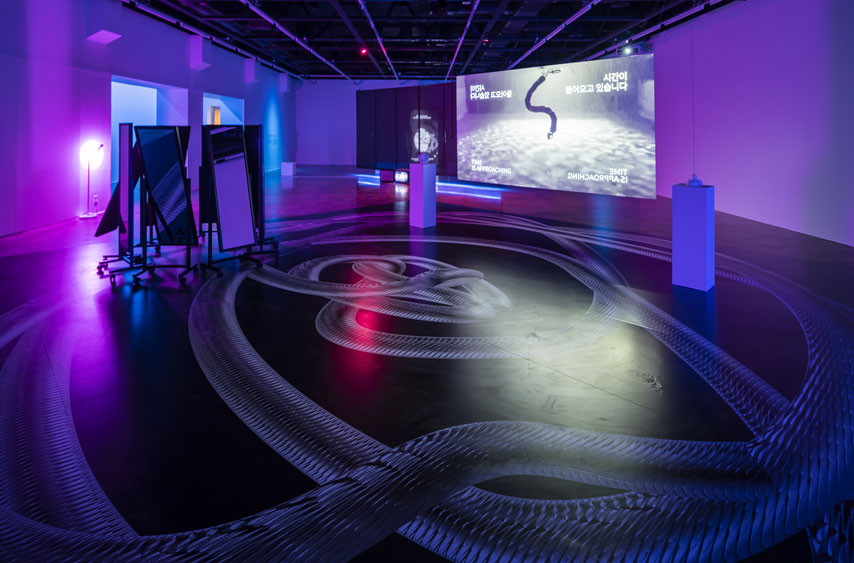
김실비
회한의 동산, 2018/2020, 단채널 영상, 4K HD 변환, 흑백, 사운드, 5분 17초, 3D PLA 프린트, 접착 시트 및 PET에 디지털 인쇄, 기립형 거울 8대
- 역광 순례길: 우로보로스의 나선, 2018/2020, 접착 시트에 디지털 프린트, 800×800cm
- 문지기 7: 강을 건너는 사람, 2018, PET, 디지털 프린트, 200×150cm
- 문지기 13: 개성 공장 노동자, 2018, PET 디지털 프린트, 200×150cm
- 문지기 10: 드론 연구자, 2018, PET 디지털 프린트, 200×150cm
- 문지기 9: 헌화하는 아기, 2018, PET 디지털 프린트, 200×150cm
- 회한의 동산, 2018, 단채널 영상, 4K HD변환, 흑백, 사운드, 5분 17초. 목소리 출연: 홍주현
- 금지옥엽, 2018, 3D PLA 프린트, 18×18×18cm
- 똬리 운동 연구, 2018, 3D PLA 프린트, 12×15×14cm
- 파고다, 2018, 기립형 거울 8대, 가변크기
회한의 동산은 ‘회한’이라는 뉘우치고 한탄한다는 정서, 일어나지 않은 사건이나 일을 그리워하는 감정, 그리고 ‘동산’이라는 구약에서의 낙원을 의미하는 것에서 알 수 있듯이 종교와 신화의 알레고리로 채워진 우화이다. 이 작업은 구약에서 등장하는 최초의 인류가 뱀의 유혹을 받고 후회의 길로 들어서는 이야기를 떠오르게 하는 동시에, 신에 대한 믿음이 자본주의 사회에서 과학기술을 향한 신념으로 대체된 상황을 비유한다. 영상은 유혹자이자 경고자인 뱀이 과거와 현재의 시공간을 연결하고, 과학기술이 구원자처럼 나타나는 현상과 뱀 로봇이 실제 구조 현장에서 아무런 기능을 하지 못했던 기술의 실패를 몽타주한다. 작업은 사찰의 공간배치가 형식화된 가람배치(伽藍配置)를 따라 구성된다. 꼬리를 삼키는 뱀의 형상이자 문화적 변형의 알레고리가 담긴 우로보로스(역광 순례길: 우로보로스의 나선)가 동산으로 가는 순례길을 구성하고, 데이터가 물질화된 3D프린트로 제작한 뱀의 오브제(금지옥엽, 똬리 운동 연구)가 스크린을 수호한다. 역사의 시간 층위를 지나 도래할 다중의 이미지는 동산으로 진입하는 문지기로서 기술과학과 자본이 만들어낸 우화의 목격자로 참여한다. 문지기를 지나 탑돌이를 하고 마주하는 파고다는 팔방을 반사하며 현재의 시공간과 과거와 미래로 거울에 비친 관객을 안내한다. 울려 퍼지는 지하철 플랫폼의 음성언어는 기계와 신체의 오작동된 연결을 이야기하는 안내자이자 계시자로 등장한다.
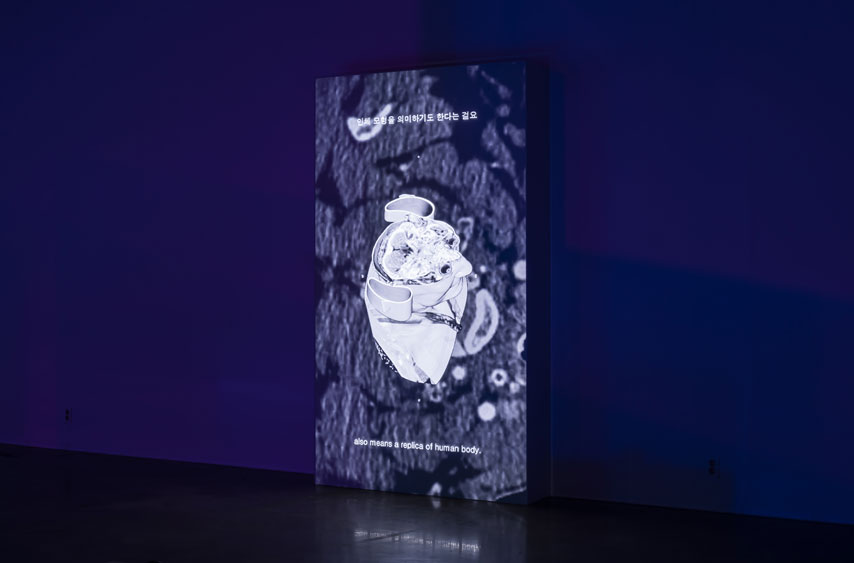
이은희
블러드 캔 비 베리 베드, 2018, 단채널 HD 영상, 흑백, 사운드, 16분 25초
블러드 캔 비 베리 베드는 기계에 포착된 신체상(像)에 대해서 다룬다. 몸이라는 상을 감각하고 인식하는 것에 대한 비디오 에세이는 마비라는 증상에서 출발하여 잃어버린 몸의 감각의 부재를 쫓아간다. 이 점멸하는 영상은 신체이미지가 기계에 의해 출력되어 유령의 이미지가 되었다가 이내 신체의 주인이 그것을 보고 공포에 질리는 기계이미지와 신체의 연속반응 속에 놓여있다. 기술과 기계가 포착하는 신체의 이미지가 낯설지만 결정적으로 다가오고, X선에 의해 포착된 죽음으로서의 형상이 나타났다 사라진다. 또 마비를 치료하는 거울치료방법으로 거울에 비친 신체상을 통해 잃어버린 신체의 감각을 되찾은 듯한 착각에 빠져들게 하고, 이로써 유령이미지는 다시 신경계에 반응하고 물리적 몸을 움직이게 한다. 이형적 형상이 반영(reflection)되어 신체의 감각이 변이되는 것을 따라가는 영상은 기술과학과 사이버네틱스가 바꾸어놓은 가상과 현실의 감각에 대한 비유로 보여진다.
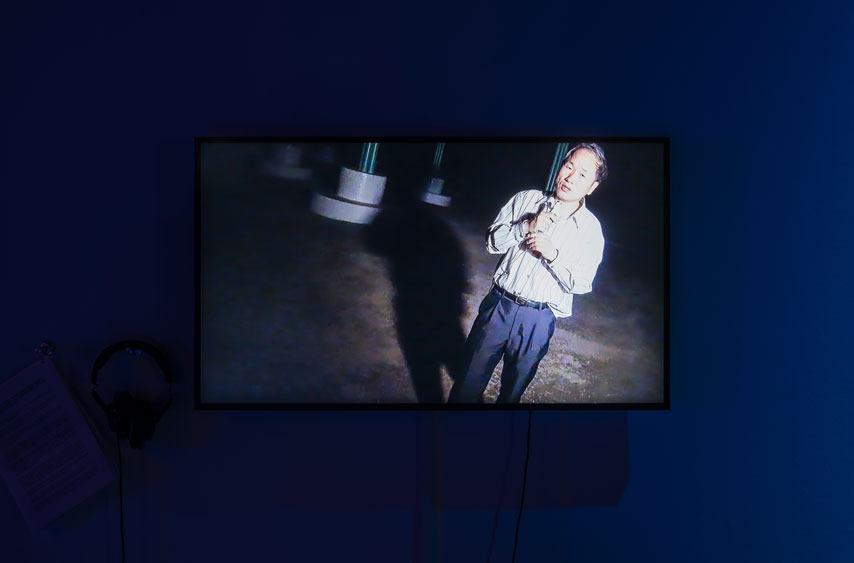
양아치
그날, 그 자리에는 창조론자, 비진화론자, 본질주의자, 종말론자, 진화론자, 실존주의자, 근본주의자, 그노시스파, 연금술사, 전체론자, 감리교도, 몽매주의자, 존재론자, 유래론자, 현상론자, 합리주의자, 혼합주의자들이 참석했습니다., 2012, 단채널 영상, 컬러, 사운드, 12분 49초
이 영상은 뇌 과학자 박문호 박사의 과학강연 퍼포먼스와 대전 엑스포 과학공원의 조형물을 교차 편집해서 보여준다. 대전 엑스포는 1993년 국가 발전의 역량을 과학기술의 미래지향적 이미지로 보여주는 이벤트이자 ‘21세기 국가 과학기술 발전’의 상징적 공간이었다. 과학공원에서 펼쳐진 뇌 과학자의 과학과 이성, 언어의 순수성과 생태계에 대한 강연은 이성이 잠든 밤의 시공간을 깨운다. 과학기술의 상징인 과학공원 내 동식물, 곤충, 행성 등의 거대모형은 불안정한 카메라 앵글과 빛에 의해 부조리하게 보여 진다. 이 작업은 과학강연의 서사를 비선형적인 편집으로 개입하면서 대전 엑스포라는 장소의 상징을 건드리며, 과학이 수학적 논리체계와 이성의 순수성에 가깝기보다 이데올로기의 영역이라는 것을 드러낸다. 2012년 프로젝트대전의 과학과 예술의 융복합적 주제인 ‘사이언스 아트’의 맥락에서 제작된 이 작업은 시차를 두고 이번 전시에서 과학적 논리와 합리주의적 이성에 균열을 가하는 자리에 상징적으로 재배치된다.
▣ 전시 연계 프로그램
온라인 오프닝
LIVE! 온라인 오픈&투어
- 내용 : 라이브 방송을 통해 큐레이터가 설명하는 더블비전 전시 소개와 전시장 투어로 진행
- 일시 : 9월 24일(목) 오후 6시
- 장소 : 인스타그램, 유튜브
*비대면 및 무관객으로 진행되며, 아르코미술관 인스타그램과 유튜브를 통해 라이브로 중계예정
전시연계 10월 프로그램
렉처
<기술유토피아의 주문(呪文)>
- 강연자 : 서동진(계원예술대학교)
- 일시 : 10월 10일(토) 오후 2시
- 장소 : 유튜브
렉처
<자동화 시대에 인간이 된다는 것>
- 강연자 : 김상민(한국예술종합학교)
- 일시 : 10월 24일(토) 오후 2시
- 장소 : 유튜브
토크 프로그램
<어펜딕스: 사용설명서>
- 내용 : 전시 연계로 발행되는 부록(Appendix)의 구성과 키워드를 중심으로 전시와 작품을 살펴보는 토크 프로그램
- 참여자 : 아그라파 소사이어티(김진주, 이연숙, 이진실)
- 일시 : 10월 31일(토) 오후 3시
- 장소 : 유튜브
*10월 프로그램은 비대면 및 무관객으로 진행되며, 아르코미술관 유튜브를 통해 중계예정
*프로그램 내용 및 온라인 플랫폼은 변경될 수 있음
전시연계 11월 프로그램
리딩클럽
- 내용 : <리딩클럽>은 SF소설을 함께 읽고, 과학기술이 도래한 오늘날의 세계에 빗대어 재해석하고 질문하며, 각자의 생각을 공유하고자 마련하였습니다. 고전처럼 읽히는 사이버펑크 소설 『뉴로맨서』 읽기를 통해 기술과학이 지배한 사회와 기업, 이로 인한 공포, 종말적인 분위기를 상기하고, 기술과 자본이 인간의 삶 속 깊숙이 관여한 현재와 미래의 모습을 비춰보고자 합니다. 전시주제에서 확장하여 회차별로 영화, 넷플릭스, 게임 등 대중문화에서 나타나는 과학기술에 대한 사회의 모습을 살펴보고, 나아가 포스트휴먼 담론과 연계하여 사유할 수 있는 기회가 될 것입니다.
- 도서명 : 윌리엄 깁슨(William Gibson) 『뉴로맨서(Neuromancer)』
- 장소 : 온라인 플랫폼 줌(Zoom)
- 일시 : 총 4회, 11월 매주 목요일(11/5, 12, 19, 26), 오후 7시30분
- 진행자 : 권태현(큐레이터, 미술비평) 미술이론과 문화연구를 공부하며 글을 쓰고 전시를 기획한다. 미술계에서 활동하지만 미술 안쪽에 있는 미술이 아닌 것들에 더 관심이 많다. 미술과 정치가 서로에게 만들어 내는 틈과 그 가능성에 대한 연구를 지속하고 있다.
- 모집기간 : ~11월 1일(일)까지
*모집 후 확정 메일을 드릴 예정입니다.
- 대상 및 모집인원 : 성인대상, 8명
- 참가비 : 무료
- [신청자 필독사항]
- - 리딩클럽의 책은 신청자 개별 지참입니다.
- - 4주동안 1권의 책을 읽는 프로그램이며, 4주 동안 참석하실 수 있는 분에 한해 신청 가능합니다.
- - 매주 사전에 일정량의 책을 읽고, 밑줄긋기 등 과제가 있습니다.
- - 온라인 플랫폼 줌(Zoom)을 통해 진행되고 프로그램은 녹화되며, 일부 편집 후 유튜브 채널로 보관, 공유될 수 있습니다.
- - 참여자분께 사전에 줌 링크와 패스워드를 보내드리며, 1회차 읽어오실 분량을 안내해드릴 예정입니다.
*신청이 마감되었습니다.
자료담당자[기준일(2020.9.22)] : 아르코미술관 남은혜 02-760-4623
게시기간 : 20.9.22 ~
2020 아르코미술관 주제기획전 《더블 비전 Diplopia》
▣ 2020 ARKO Art Center Thematic Exhibition Diplopia
- Date : 2020.9.24.-11.29
*Due to COVID19, The Schedule might be changed. Please Check ARKO Art Center website before visiting.
- Online Opening : Semtember 24, 2020, 6pm
*There will be no opening reception. Online Opening will be streamed via YouTube and Instargram Live.
- Location : ARKO Art Center Galley 1, 2
- Admission : Free
- Participating Artists : Sylbee Kim, Yangachi, Minsu Oh, EunHee Lee, Youngzoo Im
- Appendix Text: Agrafa Society
- Hosted by Arts Council Korea
- Opening Hours: Tues–Sun, 11am–7pm
*Last entry 6:30pm
*Extended hours until 9pm on the last Wednesday of each month
*Please find out online documentation film via YouTube instead of Docent Programme.
▣ Diplopia
We live in a chapter of science and technology. Artificial intelligence, robotics, and biotechnology of the Fourth Industrial Revolution convince us that our lives are made better and more convenient. The Fourth Industrial Revolution emerges as a pioneer and savior that presents us an alternative to the environmental crisis of the Anthropocene, along with a new standard of remote and contactless communication. What has also engulfed us is technology fetishism; the concentration of business and economy in science and technology, along with biotechnology’s promise of a fortified body and eternal life, attests to the current state of intoxication. Take Elon Musk, for example, the CEO of Tesla and pioneer of autonomous vehicle technology, who has recently founded Neuralink — a neurotechnology startup that can connect the human brain to a computer. These technological developments point us to a world of transhumanism, where artificial intelligence and human bodies react and connect with each other. And we glow with enthusiasm in response. This futuristic technological fantasy constantly regenerates itself, and the soaring IT industry and bio stock markets burn with desires.
The problem with science and technology, however, is that they are subject to capitalist relations of production. When mobilized for profit, science and technology alienate, datafy, automate, and financialize material lives and human bodies by the logic of technological systems. In other words, cutting-edge technology creates seamless networks and converts materials and human bodies into immaterial flows of code and data. The trajectories of sharing platforms associated with lifestyles, including accommodation sharing, car sharing, and delivery services, obscure human bodies and turn them into data entries within a network. It is perhaps not surprising that in cognitive capitalism — in which the production and consumption of data leads to immaterial labor — we repeatedly find ourselves trapped in the reality of subordination to the world of cybernetics.
In the face of our omnipresent aspirations for the Fourth Industrial Revolution and science and technology, the 2020 ARKO Art Center Thematic Exhibition Diplopia aims to examine the phenomena in which science and technology intertwine with capitalism. It further attempts to see the world behind this biopolitical sphere that is deeply ingrained in our lives, bodily senses, and cognitive systems. Diplopia questions the possibility of escaping the world of technology and market economy that repeatedly subsume human subjectivities. If not possible, the exhibition will instead explore our perceptual and sensory conditions morphed by machine-system relations, and anticipate the transmuted future yet to come.
Furthermore, Diplopia attempts to shift the flow of anthropocentrism and technological fetishism — fueled by scientific and technological optimism — and ask: how are the current state, scenes, and images created by science and technology rupturing human existence? In what ways are they transforming human lives? How is it possible for humans to make a turn to reestablish relationships with machines and systems without becoming alienated and obsolete?
Human beings, who experience and connect with various scientific, technological, and mechanical systems, now have no choice but to reformulate our own bodies and cognition. On the one hand, the need for reformulation attests to the fact that humans are imperfect beings who are influenced by affect and relationships. Humans are alienated and become subordinate to mechanics, but at the same time, the interactions with non-humans (i.e., machines) lead us to question our anthropocentric ways of possessing technologies. It is through this process that humans can crack open rooms to negotiate with non-humans/machines/systems, whether they are entirely heterogeneous or integrated with humans.
The title of the exhibition refers to a medical condition called “diplopia,” or a “double vision.” The show takes these terms as a symptomatic condition of our world and attempts to reveal dual vision ingrained in that condition. It leads us to face human alienation, a pathological reality that lies behind technological fetishism; it also leads us to collectively imagine a renewed and reciprocal relationship between humans and non-humans. Our century is characterized by its blind faith in science and technology, the scenes that manufacture fantasies, and the state of subordination propelled by the intricate web of machine-system and capital-driven production. In this state of subordination, the exhibition attempts to envision a relationship in which humans and machines do not confront but intersect with each other. And in this intersection, human and non-human visions start to overlap. The participating artists explore issues of labor and body overshadowed by systems of capitalism and technology. They also explore images of humanity captured by machines and present the affect of anxiety and visions of the near future with moving images and sounds. The double structure of the exhibition space, divided into two floors, leads us to organically connect and interpret the works. And the rest remains as a possibility, reserved for our imaginations to fill the chapters yet to come.
Featured Works

Yangachi
Sally, 2019 present, 3-channel video, color, sound, 9min 19sec
Sally, 2019 present, 1-channel video, color, sound, 6min 40sec
Sally Smiles, 2020, silicone, mineral, 17×13×14cm
Sally shows the datascape of a near-future smart city of Seoul, guided by artificial intelligence named Sally. In this work, Yangachi predicts changes in our lifestyles and environments based on the technical knowledge of artificial intelligence, energy, robots, and smart cities. Can production and consumption of data, along with Platform Capitalism, transition into a model that generates basic income? Can autonomous driving and accompanying technology connect us between time zones, scales, and spaces? Will there be an emergence of new bodies that can sense and access the network? Will those bodies be able to change their sense and perception? The prophecy of artificial intelligence of the near future, that assures us "everything will soon be connected," leads us to question whether a physical being can meet human bodies via World net where everything is connectable. The video is projected as both a visual imagining of and an advertisement for the future of technology lying ahead of us. While Sally, the artificial intelligence from the future, speaks to us from the screen, Sally Smiles — the object placed in the exhibition hall — radiates the light absorbed from another medium. Calcite, a mineral attached to an object, is a mythical and naturally derived mineral used during Viking voyages to determine the sun’s direction. Like the future, the ancient time of the Vikings can also be connected via imagination; in this sense, the work connects the medium of the past with that of the future, and welcomes the audience by becoming a signal that conjoins both exhibition halls.

Minsu Oh
Outsourcing Miracle, 2020, speakers, motors, mixed media, dimensions variable
A work composed of amplified mechanical sounds and kinetic installations, Outsourcing Miracle is about the death of laborers who disappear behind the capitalist system. “Outsourcing” is a system adopted by corporations in order to speed up the production process. Subsumed by this corporate structure, working-class people become subject to precarity. The artist attempts to reveal the conditions of labor in mega-corporate structures by recording the sounds at the destruction of Icheon warehouse (April 29, 2020) and projecting them in the exhibition space. The white noise, recorded at the scene of the fire, flows through the speakers that move up and down the exhibition space; what results is the doppler effect, a distortion of sounds that is amplified and reduced by the movement of the speakers. Through sound installations, the work further speaks of the management structure of the market economy, sacrifices made in the name of corporate productivity, and the irreproducibility of disasters. The distortion of sound obscures the irreproducible time; it also guides us to a time and sound yet to be experienced. The blazing and irreversible fire from the site of disaster in Icheon comes alive in the form of fleeting white noise, and in the face of obscured time and sound, we come to sense the instant of death.

EunHee Lee
AHANDINACAP, 2020, 3-channel Full HD video installation (in-sync), color, sound, 13min
Through a three-channel video, AHANDINACAP suggests how physical deficiencies are determined in a capitalist society and how technology and science are mobilized to overcome those deficiencies. Starting with footage from a movie, this video is composed of a narrative of becoming a post-human in order to overcome disabilities, the set of criteria used by insurance companies to determine what classifies as a disability, the movement of the performer, and a robot used for rehabilitation therapy. In the name of overcoming disabilities, the science and technology industry promotes the development of prosthetics that attach machines to the human body, creating a cyborg. The artist explores the meaning of the “disable-bodied,” the etymological source of disability, and questions if the capitalist perspective on disability results in the dichotomy between “defective” and “recovered, therefore able to work.” She further questions the division of normality and abnormality—a condition to determine what classifies as disabilities—and reveals the aggrandizing presence of cutting-edge technology in the dichotomous disability industry with interviews of care workers and a person with a disability.

Youngzoo Im
Theta, 2020, 4-channel video installation, color, sound, 17min 52sec
Theta invites us to perceive our unpredictable and unstable existence through meditative and fragmented senses. Our daily lives in a chaotic world might look peaceful yet are full of precarity, variants, complexities, and interrelationships. Take technology for example: it has deeply entered our everyday lives in the form of platforms and has become inseparable from life. Our everyday routines connected by technology deter our perceptions from clearly delineating boundaries between the real and the virtual. In the midst of the confusion and illusion between those blurred boundaries, ethical judgement is suspended, while the subject of grief becomes unclear. Theta sheds light on ways we encounter and perceive uncertain events, and the condition where technology or capital has been so internalized that it has become a part of humans. To Im, science and technology is a medium for introspection and overcoming of the physical body to reach the outer world. In this work, the artist, who has explored the structure of faith, implies the hope and fantasy attached to technology and capital of our time. She questions whether the whole of humanity is experiencing phantom pain — a painful sensation from a body part that no longer exists — and whether we are at the brink of an unfathomable end of the world.

Sylbee Kim
Garden of Regrets, 2018/2020, single channel video, 4K transferred to HD, B/W, sound, 5min 17sec, 3D PLA print, digital print on PET and adhesive sheet, 8 freestanding mirrors
- Backlit Pilgrimage: Spiral Ouroboros, 2018/2020, digital print on adhesive sheet, 800×800cm
- Gatekeeper 7: On the Bridge, 2018, digital print on PET, 200×150cm
- Gatekeeper 13: Kaesong Factory Worker, 2018, digital print on PET, 200×150cm
- Gatekeeper 10: Drone Specialist, 2018, digital print on PET, 200×150cm
- Gatekeeper 9: Baby Offering Flowers, 2018, digital print on PET, 200×150cm
- Garden of Regrets, 2018, single channel video, 4K transferred to HD, B/W, sound, 5min 17sec. Voice-over: Joohyun Hong
- Apple of Your Eye, 2018, 3D PLA print, 18×18×18cm
- Study of Coiling Movement, 2018, 3D PLA print, 12×15×14cm
- Pagoda, 2018, 8 freestanding mirrors, dimensions variable
As the title suggests, Garden of Regrets is an allegory of religion and myth. The word “regret” refers to the feeling of guilt, remorse, or longing for an event that did not happen; the word “garden” resonates with the Garden of Eden of the Old Testament. In this sense, Garden of Regrets is evocative of the story of the first humankind who gets tempted by a serpent and thus enters a path of regret, while at the same time being a metaphor of the situation in which the capitalist belief in science and technology supplants faith in God. In the video, a serpent — the agent of seduction and warning — connects time and space of the past and present. Science and technology appear like a savior, but that scene is also montaged with that of a serpent robot that is rendered useless at the actual site of rescue. As a whole, the work is structured according to the Garam layout, a formal arrangement of Buddhist temples. The pilgrimage route to the garden is constituted by ouroboros, the shape of a snake swallowing its tail that embodies allegories of cultural transformation (Backlit Pilgrimage: Spiral Ouroboros). And 3D prints with patterns of snake skin as a materialized version of data guard the screen (Apple of Your Eye, Study of Coiling Movement). Portraits of anonymous multitude who arose through recent history confront the viewers as both Gatekeepers of the garden and witnesses to the fable created by science, technology, and capital. Passing the Gatekeepers, one can circumambulate Pagoda that reflects eight directions and guides the audience (who are reflected in the mirror) into the present, past, and future. The voiceover from the video reverberates like a public announcement: as a guide and prophet, it narrates the malfunctioning conjoinment between a machine and a human body.

EunHee Lee
BLOOD CAN BE VERY BAD, 2018, single channel HD video, B/W, sound, 16min 25sec
BLOOD CAN BE VERY BAD engages with body images captured by machines. A video essay on sensing and perceiving body image, the narrative begins with paralysis and follows the absence of sense in the lost body. The flickering video alternates between ghostly body images produced by machines and mechanical images of humans (the owner of the bodies) seeing their bodies and gasping in terror. The body images captured by technology and machines approach us in unfamiliar yet decisive ways, while death captured by X-rays keeps appearing and disappearing. Mirror treatment, a method to cure paralysis, falsely retrieves the sensations of the lost body through the reflection in the mirror. This phantom image, in turn, reactivates the nervous system and physically moves the body. The video traces this transformation of the bodily senses that takes place after encountering the heteromorphic mirror reflection of the self. This transformation subsequently becomes a metaphor of the virtual and real senses that have been morphed by technology, science, and cybernetics.

Yangachi
There were creationists, fixistes, essentialists, eschatologists, evolutionists, existentialists, fundamentalists, gnosists, originists, externalists, rationalists, and syncretists., 2012, single channel video, color, sound, 12min 49sec
There were creationists, fixistes, essentialists, eschatologists, evolutionists, existentialists, fundamentalists, gnosists, originists, externalists, rationalists, and syncretists. cross-cuts neuroscientist Dr. Park Moon Ho’s lecture performance with Daejeon Expo Science Park’s sculptures. The 1993 Daejeon Expo was an event that showcased the development of a nation through futuristic images of science and technology. It was also a symbolic space for the “national development in science and technology of the 21st century.” The neuroscientist’s lectures on science, reason, purity of language, and ecosystems, which took place at Science Park, illuminate darkness and its dormant reason; the giant models of animals, plants, insects, and planets at Science Park — the heart of science and technology — are clumsily lit by unstable camera angles and lighting. Intervening with the narrative of the science lectures through nonlinear scenes and edits, the work revives Daejeon Expo. It reveals the ideological dimension of science that is far from mathematical logic and reason. Produced in response to “Science Art,” an interdisciplinary theme of science and art from 2012 Project Daejeon, the work strides a temporal gap, resituates itself in this exhibition, and ruptures scientific logic and rationalism.
▣ Related Programs
Online Opening
LIVE! Online Open & Tour
- Date : Thursday, September 24, at 6 p.m.
- Place : ARKO Art Center Galley 1, 2, Instagram, YouTube
*This programs will take place via YouTube and Instagram Live.
Related Programs in October
Lecture 1
"The Spell of Technical Utopia"
- Speaker : Dongjin Seo (Kaywon University of Art and Design)
- Date : Saturday, October 10, 2020 at 2 p.m.
- Platform : YouTube
*Check out our post updates about the program.
Talk Program
“Appendix: Instruction”
- Moderator : Agrafa Society (Jinjoo Kim, Yeonsook Lee, Jinsil Lee)
- Date : Check out our post updates about the program.
- Platform : YouTube
Lecture 2
“"Being Human in the Age of Automation"”
- Speaker : Sangmin Kim (Korea National University of Arts)
- Date : Saturday, October 24, 2020 at 2 p.m.
- Platform : YouTube
*Check out our post updates about the program.
*All programs in October will take place via YouTube (ARKO Art Center)
*The content of programs and online platform could be changed.
Related Programs in November
Reading Club
- Platform : Online Platform *Check out our post updates about the program.
- Date : Wednesday, November 4, 11, 18, at 6 p.m.
*You can participate in programs by applying on the homepage and SNS.
자료담당자[기준일(2020.9.22)] : 아르코미술관 남은혜 02-760-4623
게시기간 : 20.9.22 ~